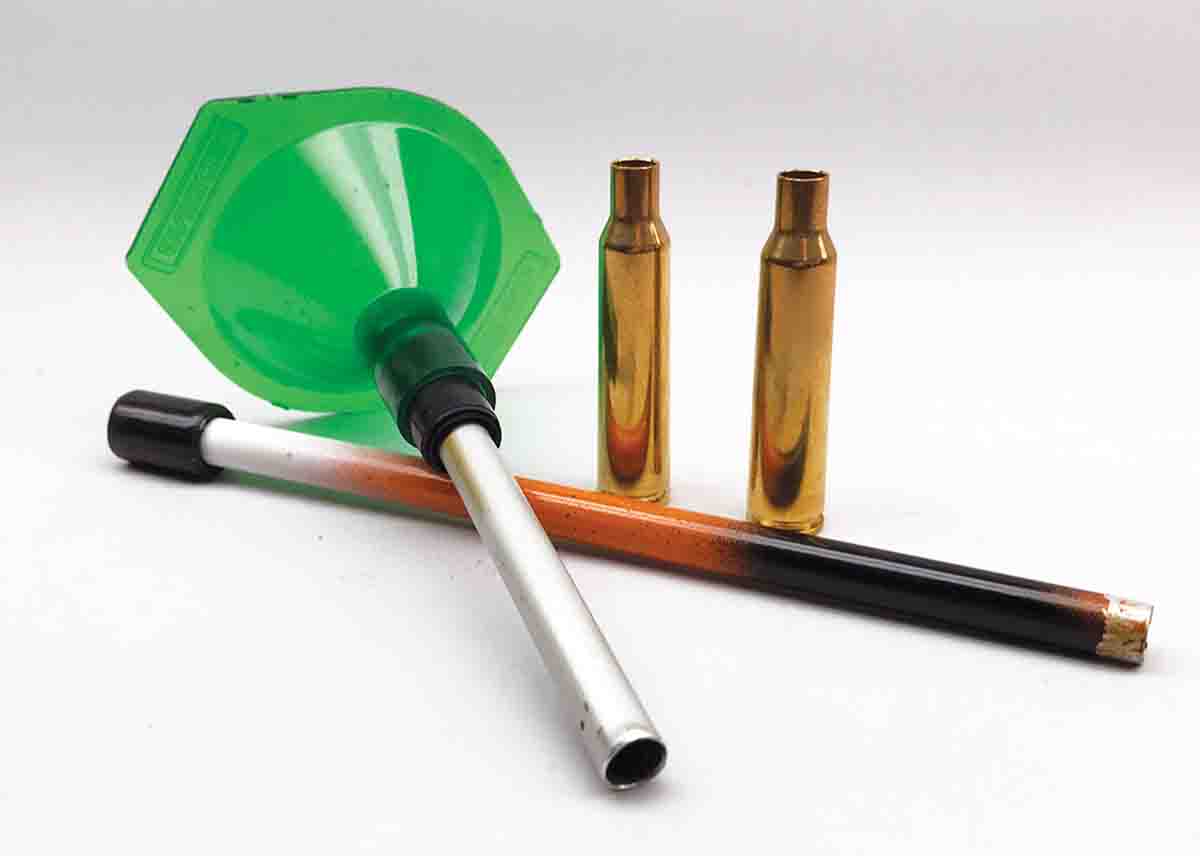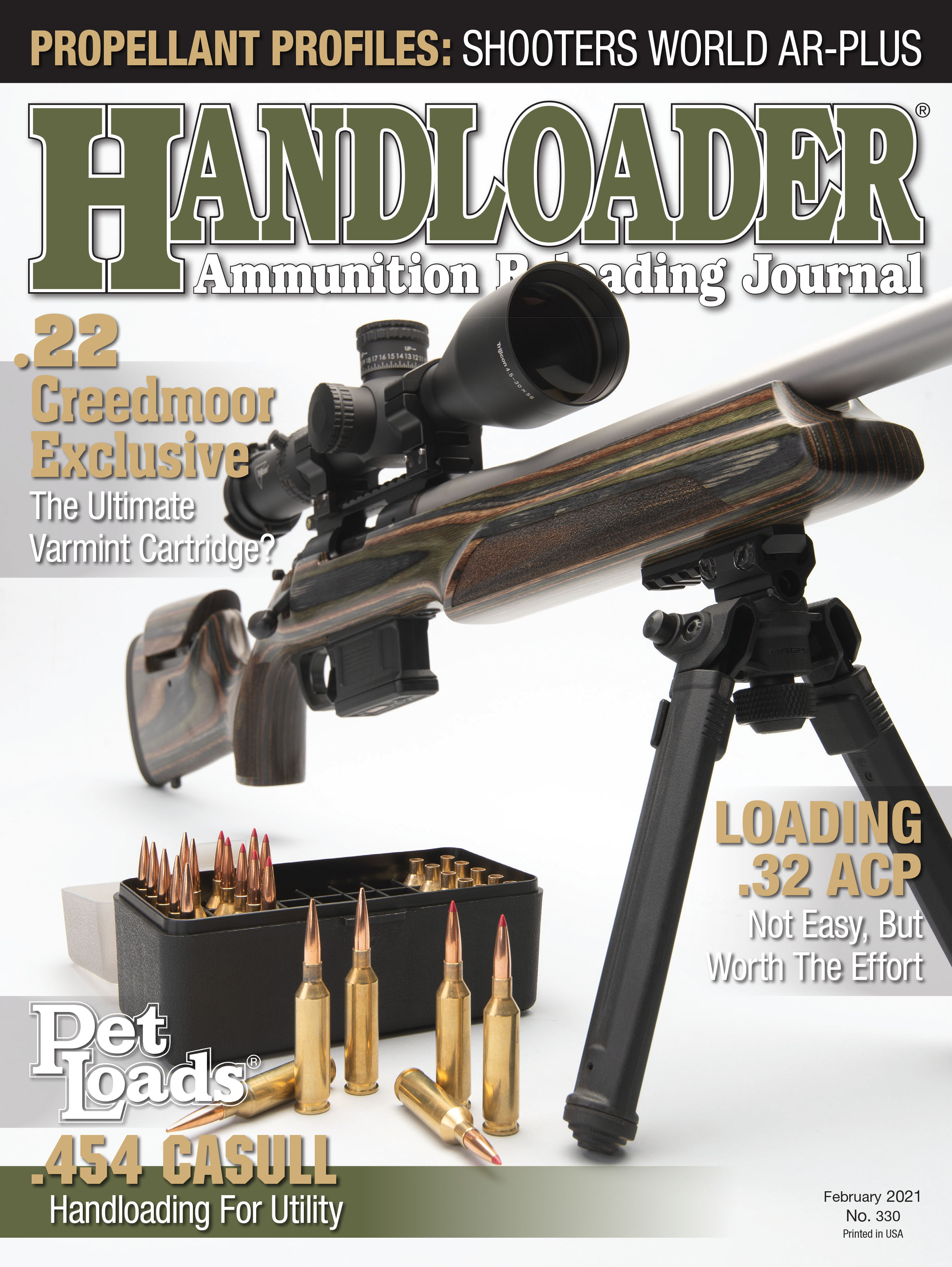Reloader's Press
The Same Old - Over and Over
column By: Dave Scovill | February, 21

I attributed the cause of both problems to distractions. It doesn’t really matter what the distractions were, since anything that draws attention away from the matter at hand is bad news. In those days, I didn’t have a loading block. Following the squib event, I went out to the barn and made one out of a nice piece of redwood 2x6. The hole spacing wasn’t perfect, but the blocks allowed for the last and possibly most important observation, verifying the charge weight on the Redding powder scale, pouring it into the case and looking down in all of the cases (with a flashlight) to make sure they are all filled to the same level.
Folks can wait until the end of the loading process to verify that all the cases have the proper powder charge, but it is best to do so after pouring each charge as well, just in case you are reading the scale wrong for one or more charges or one of the scale weights was bumped. This applies whether you are using a powder measure, scale or electronic measure, since mistakes tend to repeat themselves without notice; and “bridging” with stick/extruded IMR-type powders are always a potential problem that can leave a partial charge in one case and an overcharge in the next case, or vice versa.
Using the same process, even with the aid of a checklist to make sure everything follows in proper order, and “view to verify” to make sure it happened, is necessary to maintain order and control. Then too, doing the same thing over and over again and expecting a different result in terms of accuracy is the classic definition of insanity. It often pays to change the process a bit, such as using a different primer, brand of case or bullet seating depth with each set of 5 to 10 rounds for testing without losing a grip on the process and being distracted. The motivation then in the following tests is to determine if minor changes have a noticeable or measurable effect on performance. That is, seemingly otherwise minor changes offer motivation (enthusiasm) for testing, vice the same old routine with sometimes boring expectations.
That is to say, seating all the bullets to within the same nano-inch of the lands is folly. It is best to change the seating depth and make notes in the load development stage. Some bullets, like the Barnes TSX, shoot best when backed away from the lands, up to .035 or .040 inch. Bullet costs have gone up, and using the same seating depth for all loads, e.g., following the assumption that seating to within a nano-inch of the lands will develop BEST accuracy, may prove a waste of time and money if accuracy isn’t compared with other seating depths.
Back in the day, it was common for writers to insist that longer, heavier bullets would produce best accuracy, especially in long military-type leades that put the bore diameter of the bullet ogive as close as possible to the lands. Assuming somewhat oversized chamber throats, leades and barrels were somewhat common, most folks blamed the bullet for lousy accuracy. Nowadays, considering advertising, bullets are largely regarded as perfect and barrels nearly so, so accuracy is solely dependent on bullet seating depth.
Folks have also advised that they have changed the powder, sometimes primer, etc., but still use the often recommended nano-inch bullet seating depth philosophy and continue to get minute-of-baseball-sized groups while in pursuit of golf-ball-sized clusters.
Another pit handloaders can fall into is using the same primer, exclusively. I used CCI 250 and 200 primers extensively for several years, largely because they were always available, while local supplies of Winchester or Remington primers were somewhat sporadic. Accuracy and velocity were satisfactory for hunting purposes, so the lack of other brands wasn’t a big deal.
Several years ago during the shortage of primers, powders and .22 LR ammunition nationwide, I was traveling through Kansas and spotted a Cabela’s store near the freeway in Wichita. They had everything I might like to try, including Winchester Large Rifle Magnum (WLRM) primers, Remington 9½ Large Rifle primers, newer Reloder powders and a good supply of .22 LR ammunition.
The next loading project in a 7x57mm Mauser with a new cut-rifled barrel using WLRM primers appeared to have a positive effect on overall group size by eliminating fliers with four powders and three bullet brands, although the long leade ahead of the chamber left bullets that were seated to one-caliber seating depth on average, about .030 to .040 inch off the lands, depending on bullet weight.
Not surprisingly, when the 7x57mm results were summarized in a column, a reader noted the improvement in overall accuracy was because the Nosler cases were match prepped. He apparently chose to ignore the fact that none of the bullets were seated anywhere near the rifling and the use of WLRM primers, either of which, or both, could have been responsible for the lack of fliers, or not. Without more testing, any conclusion lacks credibility. My science teacher in school called that “jumping to conclusions.”
Sometime later, I was looking at a target with a couple of groups with one shot slightly out of the otherwise reasonable one-inch, five-shot cluster. Other groups on the target had a single shot out of the .75- to 1.0-inch group as well. Some shots were pulled randomly to the left, right, up or down. At first it appeared those shots were pulled, but it was impossible to tell which shot was pushed or pulled.
It might easily be the case that one, two or three out of five shots are actually pulled into a group and the fourth and fifth shots, not necessarily in that firing order, landed where the real group should be if the shooter could stop flinching, jerking the trigger, misjudging the wind, or the front of the sling and/or its anchor hit the forward bag to various degrees during recoil.
Eventually I mentioned that there might be a 50/50 chance of pulling a shot into or out of a group to Al Miller, editor of Rifle and Handloader magazines at the time. Al was a World War II veteran, experienced rifle shooter and former instructor to U.S. Army General staff officers. Al’s response was that most people simply figure they pulled a shot out of a group because they hadn’t learned how to “call” their shots. That is, when the trigger is pulled, skilled shooters can see the sights in terms of how they appear against the desired point of aim. If they see the reticle drift slightly away from the intended point of bullet impact, they can call the shot left, right, a bit high, etc. Al mentioned more than once over the years that an accurate rifle should form a nice round pattern around an inch (plus/minus) in diameter around the point of aim with military sights, maybe a bit smaller cluster with an accurate scoped sporting rifle using good loads.
Al went on to say, to paraphrase, average shooters tend to believe they pulled a shot out of group and ignore shots that appear to be part of a group, because they failed to see the position of the sights against the backdrop of the target when the trigger is pulled. In many instances, apparently, a novice subconsciously blinks at the sound of the rifle or the recoil, and because his/her eyes are closed, they can’t call the shot. In other words, an inexperienced shooter may not be aware the group forms around a number of “pulled” or “pushed” shots, albeit clearly adequate for hunting deer-sized game.
For long-range target work, either black powder or smokeless, the shooter and spotter work as a team, since the target is often too far away for the shooter to see it clearly with open sights or a scope. Military snipers often work with a spotter as well. Folks who have worked with sporting and target rifles for years sometimes resort to an “iron monster” rail gun to test inherent accuracy of the cartridge and eliminate the human element all together, save for whoever manufactured the machine.
So, we are back to square one. When testing ammunition, handloads or factory fodder, discounting obvious fliers that are pulled out of a group is standard policy with some shooters. Moreover, it was fashionable, when affordable chronographs came on the scene, for shooters to ignore shots that didn’t conform to some hypothetical standard for velocity variations. As one scribe put it, folks purchased those fancy machines for the additional information they provided, then ignored it or squirreled numbers around until they met expectations.
Folks also tend to overlook shots that are pulled into a group and help bolster a preconceived notion of accuracy – “It looks good so I’ll keep it.” Either assumption is little more than doing the same thing over and over again based on the fact that some handloaders think they are better shots than they really are, which helps explain all the hyperbole over new wonder cartridges that inevitably fall short of expectations.


